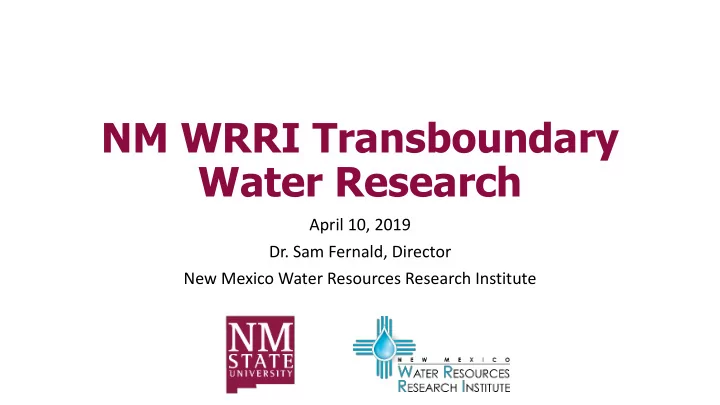

NM WRRI Transboundary Water Research April 10, 2019 Dr. Sam Fernald, Director New Mexico Water Resources Research Institute
Transboundary Aquifer Assessment Program (TAAP)
TAAP Purpose “… cooperat[ion] with the States on the border with Mexico and other appropriate entities in conducting a hydrogeologic characterization, mapping, and modeling program for priority transboundary aquifers, and for other purposes.” -United States-Mexico Transboundary U.S. Public Law 109-448 Aquifer Assessment Act
TAAP Timeline • November 25, 2003: Senator Bingaman (NM) introduces the United States-Mexico Transboundary Aquifer Assessment Act • December 22, 2006: United States-Mexico Transboundary Aquifer Assessment Act signed into law • August 19, 2009: Agreement between IBWC & CILA signed Principal Engineers John Merino and Luis Antonio Rascon Mendoza signing the Joint Report on August 19, 2009
TAAP Priority Aquifers • Santa Cruz • San Pedro • Hueco Bolson • Mesilla Basin Source: University of Arizona Water Resources Research Center
TAAP Research for the Conejos Medanos/ Mesilla Basin by NM WRRI and USGS
TAAP Project Description • To better understand the Mesilla Basin priority transboundary aquifer, NM WRRI is addressing five major research efforts • In addition, NM WRRI will work on two coordination efforts: 1) Ongoing development of a strategic work plan for activities in collaboration with USGS 2) Coordination of activities with Mexico
TAAP Project Description, continued • Remote sensing to develop evapotranspiration (ET) fluxes for the Mesilla Valley Aquifer • S Bawazir (Associate Professor of Civil Engineering, NMSU), Z Samani (Professor of Civil Engineering, NMSU), Juan Solis (graduate student, NMSU), Kevin Bokyo (graduate student, NMSU), Jusep Artola (graduate student, NMSU) • Estimating recharge of alfalfa fields by measuring ET and soil moisture in the semi-arid Mesilla Valley Aquifer TAAP research station inside an 80 acre alfalfa field. The • instruments monitor Evapotranspiration with a weather K Boyko (Graduate Research Assistant, NMSU), A Fernald (Director, station, Eddy co-variance tower, and net radiometer sensor NM WRRI), S Bawazir (Associate Professor of Civil Engineering, in Santo Tomas, NM. Just south of Las Cruces NMSU), Z Samani (Professor of Civil Engineering, NMSU)
TAAP Project Description, continued • Effects of changing water availability on riparian vegetation habitat and water use in the Mesilla Valley Basin Aquifer, New Mexico, US • A Tellez (NMSU Graduate Research Assistant), K Boykin (Associate Professor of Wildlife and Conservation, NMSU), A Fernald (Professor of Watershed Management, NMSU) Figure from M.S. student Aracely Tellez’s thesis
TAAP Project Description, continued • Geochemical and isotopic determination of deep groundwater as a source of discharge and salinity to the shallow groundwater and surface-water systems, Mesilla Basin, New Mexico, Texas, and Mexico • KC Carroll (Assistant Professor of Geohydrology, NMSU), AJ Robertson (Hydrologist, USGS NM Water Science Center), C Kubicki (Graduate Research Assistant, NMSU), A Fernald (Director, NM WRRI), Roland Purtschert (Senior Scientist, University of Bern) M.S. student Chris Kubicki presenting his poster Isotopic and Geochemical Characterization Data for Deep and Shallow Groundwater in the Mesilla Basin, New Mexico
TAAP Project Description, continued • Evaluating Policy and Management Instabilities in the Transboundary Mesilla Basin Hydrologic-Social System to Rectify Public Health Concerns • A Page (Program specialist, NM WRRI), S Fernald (Director, NM WRRI), S Langarudi (Post-doctoral research scientist), S Forster-Cox (Professor of Public Health, NMSU), H Rahman (Assistant Professor of Public Health, NMSU) Photo credit: (Torres, 2017)
Transboundary Research Coordination Beyond TAAP
Border Alliance: series of NSF-funded workshops • Focus: “complex set of problems related to health, education, environment, security, inequality and the movement of goods and people faced by communities along the U.S.- Mexico border” • San Diego | Tijuana: June 5-7, 2019 • El Paso | Las Cruces | Cd. Juarez: June 10-12, 2019 U.S. planning partners for the Border Alliance
Border Alliance Breakout Session • June 11, 2019: Las Cruces, New Mexico • Title: Innovative, multi- disciplinary themes and partnerships to produce water research that addresses needs of the US-Mexico border corridor The session will take place on NMSU’s campus Photo credit: Peggy Risner, NM WRRI
NSF-funded follow-up meeting • August 8-10, 2019: San Miguel de Allende, Guanajuato, Mexico • Purpose: Researchers will build on the themes developed during the Border Alliance breakout session to determine tangible research outcomes and objectives for funding The meeting will take place at Hacienda Santa Clara in San Miguel de Allende Photo credit: Hacienda Santa Clara
Contact Information Dr. Sam Fernald New Mexico Water Resources Research Institute Water Science and Management https://nmwrri.nmsu.edu/ 575-646-4337 afernald@nmsu.edu
Recommend
More recommend